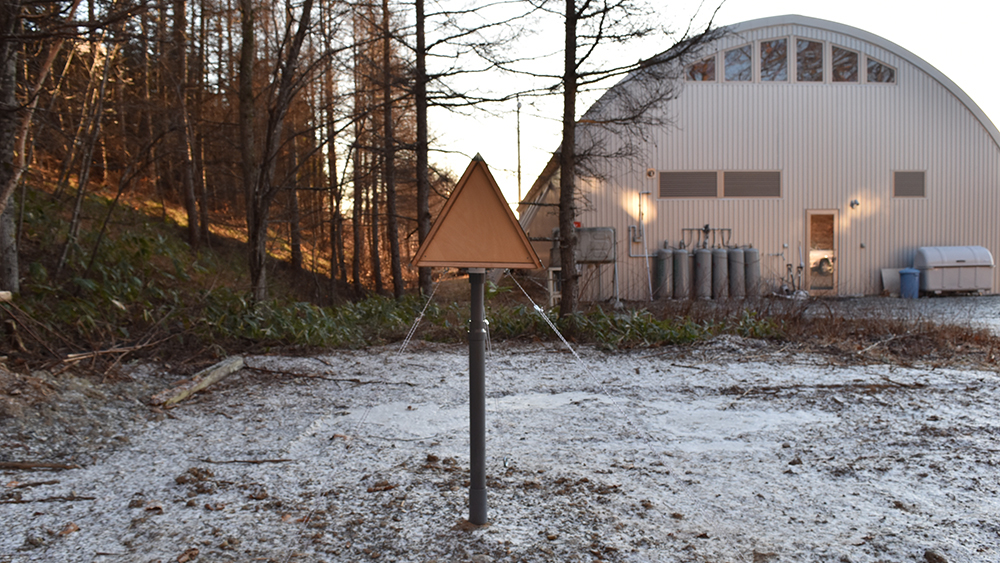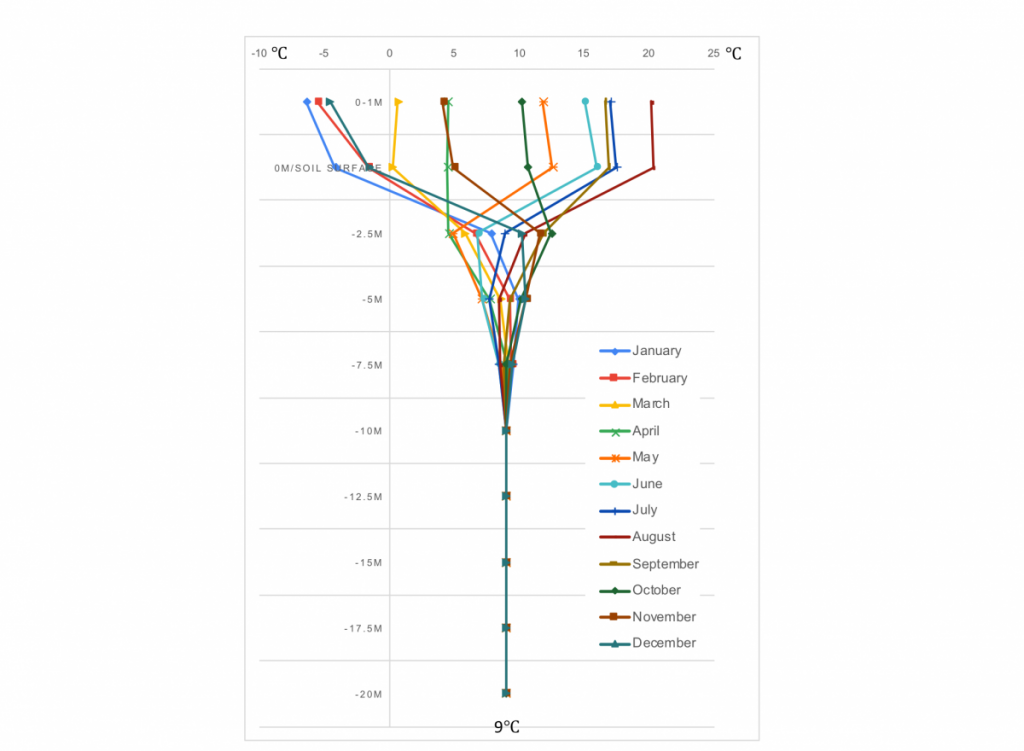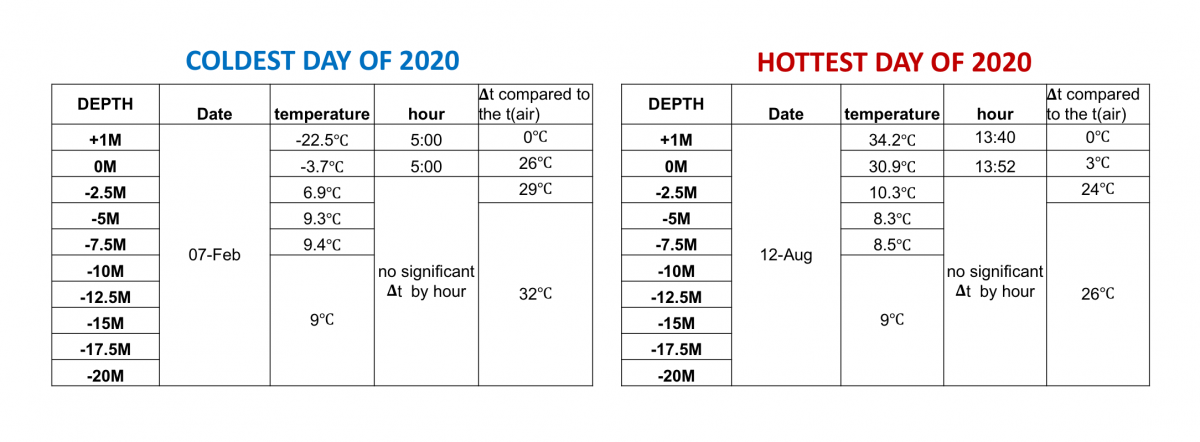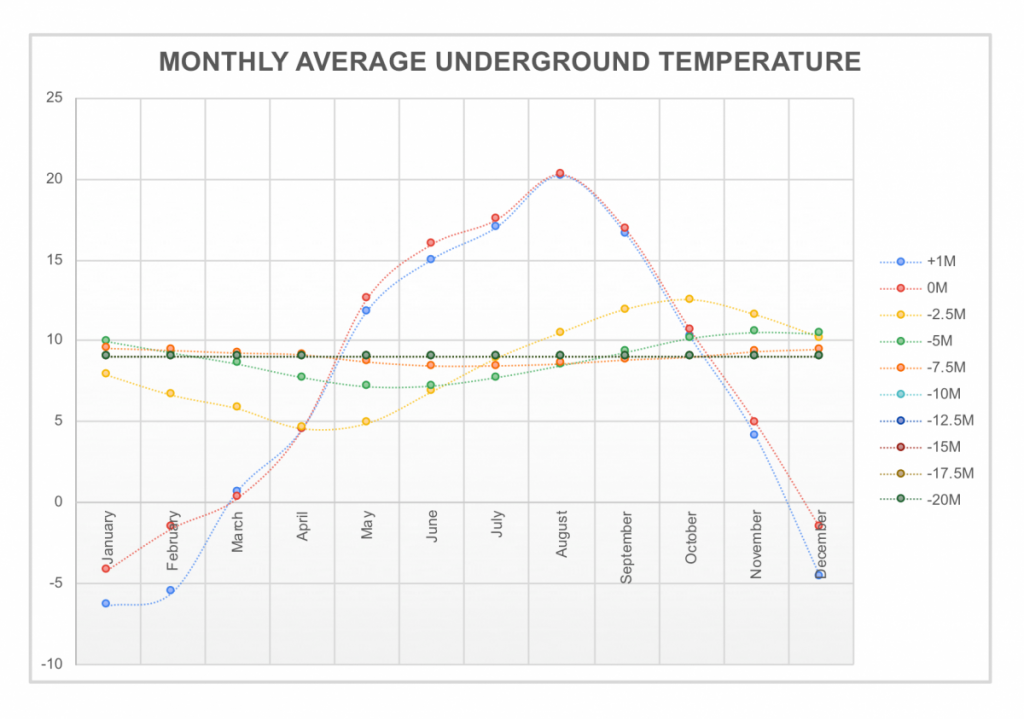research in progress
“shallow subsurface – temperature”
text: Hande Unlu
The University of Tokyo, Institute of Industrial Science
published on April 26th, 2021
–

potential that lies in the underground temperature
Underground heat has always been a great potential of energy resource and habitat to varied activities for a long time in the world history¹. Therefore, reading the underground soil structure and looking for possible effectors like nearby aquifers and water well, which all might affect the underground temperature, was necessary to understand the nature lying underneath Memu.
reading the underground temperature for a year
Following the underground survey (#shallow subsurface – geology), we installed 8 temperature sensors inside the borehole at every 2.5m under the ground until -20 meters. Additionally, we installed a sensor at 1m high above the ground to read the outdoor temperature.
After temperature sensors started their operation, we also installed a water level sensor at 15m deep inside the hole.
In 2020, temperature and water level sensors provided us to monitor around-the-year natural phenomenon occurring underneath Memu.
what we found underneath Memu…
In 2020, all year-long hourly recorded temperatures showed us that at Memu, regardless of the above-ground being extremely cold or hot, the temperature is quite stable after 2.5m under the ground, unlike the outdoor conditions (see Figure 1). Particularly, after 10 meters of depth, the ground has a stable 9 °C temperature all year round.

Figure 1. monthly average underground temperature
The impact of outdoor conditions was found majorly on the surface of the soil and gradually fades until 10 meters. The earlier boring survey showed us that the soil substructure until 3.30 meters was silty-sand (which has poor thermal conductivity) and contained very little amount of water. This finding could explain the large temperature changes observed between the subsurface’s 0- 2.5m depth. However, with the increased amount of water from 7.6m and below and changed soil density, thermal conductivity properties have improved and provided a more stable temperature underneath Memu (1).
During the coldest day of the year (see Table 1), while the outdoor temperature was -22.5°C, at 5:00 am in the morning, under the ground at Memu was between 6.9°C to 9°C, which was about 32°C warmer than outdoors. On the other side, during the hottest day of the year with a 34.2°C temperature outside, the underground was only between 9°C to 10.3°C, which was about 26°C cooler than the outdoor temperature (see Table 1).
Table 1. coldest and the hottest underground temperature readings in 2020; (𝚫t: temperature difference, t(air): air temperature)

Another fact analyzed from the readings is that the outdoor temperature was reflected upon underground with a 1 to 3 months delay in time (see Figure 2 and Table 2). For example, the coldest time of the year in the air was January 2020. However, exactly this time of the year showed the warmest temperature at -7.5m under Memu. The average temperature difference (μ𝚫t) between the coldest month and the hottest month of 2020 was 26℃ in air, whilst this difference was as little as 7℃ at -2.5m and only 0-1℃ after -10m.

Figure 2. monthly average underground temperature in 2020
Table 2. coldest and the hottest underground temperature readings in 2020 by the depth

Our literature review and expert interviews about the geological properties of the South-Tokachi region showed us that the underground temperature rises about 1.5℃ at every 100 meters below the earth’s surface (2). Therefore, based on this given range of temperature rise, one could expect 10.5℃ to 11.5℃ of heat about 100m below Memu.
Details about the shallow subsurface’s geological and thermal conductivity properties at Memu are discussed under #shallow subsurface – geology.
potentials driven by the underground temperature
In summary, reading the underground temperature at Memu has surprised us by being vastly different than the air temperature for the given same time of the year. Particularly, underground offering a cool ambient during hot summer days and offering warm ambient during the coldest time of the year makes us see it as a favorable space for varied activities and a good source of energy.
Given that the rural conditions of the location ( infrastructural limitations, such as electricity distribution of the grid and heating demand during winter) by the explored potential lying in underground temperature could create self-sustaining solutions to overcome the limitations.
footnotes
1. Geothermal resources and underground heat have provided comfortable habitats for living and storing food for centuries (3). There are written records of geothermal usage in China which are over two thousand years old (4). Shallow ground geothermal heat has been effectively used on the household level for heating, hot water provision, and cooling (5, 6). Previous research showed that under the same climatic condition, the geothermal energy (Ground Sourced Heat Pump) system could save energy by 26–60% when working in heating mode, and 19–55% of energy could be saved when the system was working in cooling mode (7). Another benefit of utilizing underground heat is that it is independent of weather conditions and outdoor climate. Under the surface soil, the earth has a stable and comfortable temperature (8). Overall, the possibilities of effective use of geothermal heat are specific to the location. Currently, geothermal power has been left behind wind and solar in both growth and installed capacity. The main reasons may be a high initial investment, long payback time and construction time, difficulty to assess resources, and difficulty to modularize. Nevertheless, geothermal power has the potential to grow exponentially in the future (9).
references
(1) Márquez, J.M.A., Martínez Bohórquez, M.A. and Gómez Melgar, S., Ground Thermal Diffusivity Calculation by Direct Soil Temperature Measurement. Application to very Low Enthalpy Geothermal Energy Systems, Sensors 2016, 16, 306; doi:10.3390/s16030306
(2) Hiroshi Wakahma, Fujio Akita and Takeo Matsunami, Explanatory Text of the Geothermal Gradient Map of Hokkaido, Geological Survey of Hokkaido, 1995
(3) Alkaff, Saqaff A., Sim. S.C., Efzan, M.N., A review of underground building towards thermal energy efficiency and sustainable development, Renewable and Sustainable Energy Reviews, Volume 60, July 2016, Pages 692-713
(4) Fridleifsson Ingvar B., Geothermal energy for the benefit of the people, Renewable and Sustainable Energy Reviews, Volume 5, Issue 3, September 2001, Pages 299-312
(5) Dingfeng Caoa, and et.al., Investigation of the influence of soil moisture on thermal response tests using active distributed temperature sensing (A–DTS) technology, Energy & Buildings 173 (2018) 239-251
(6) Grab, T., Storch T., Gross, U., Performance of a geothermal heat pipe using propane, ASME 2011 International Mechanical Engineering Congress & Exposition, ColoradoU.S.A. Nov.11-17 (2011)
(7) Urchueguia J.F., Zacares M., Corberan J.M., Montero A., Martos J., Witte H., Comparison between the energy performance of a ground-coupled water to water heat pump system and an air to water heat pump system for heating and cooling in typical conditions of the European Mediterranean coast, Energy Conversation Management, 49 (2008), pp. 2917-2923
(8) Florides G., Kalogirou S., Ground heat exchangers—A review of systems, models and applications, Renewable Energy 32 (2007) 2461–247
(9) Keween Li., Bian, H., Liu C., Zhang D., Yanga Y., Comparison of geothermal with solar and wind power generation systems, Renewable and Sustainable Energy Reviews, Volume 42, February 2015, Pages 1464-1474